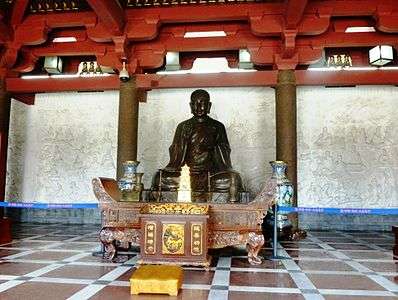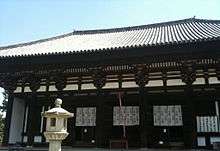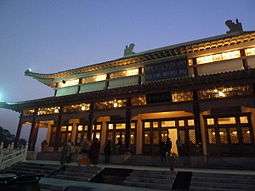East Asian Yogācāra
| Part of a series on |
| Chinese Buddhism 汉传佛教 / 漢傳佛教 Hànchuán Fójiào |
|---|
 |
|
Major figures |
|
Architecture |
East Asian Yogācāra (traditional Chinese: 唯識宗; pinyin: Wéishí-zōng; Japanese: Yuishiki-shū "'Consciousness Only' school" or traditional Chinese: 法相宗; ; pinyin: Fǎxiàng-zōng, "'Dharma Characteristics' school") refers to the traditions in East Asia which represent the Indian Yogacara system of thought.
Etymology
The term Fǎxiàng itself was first applied to this tradition by the Huayan teacher Fazang (Ch. 法藏), who used it to characterize Consciousness Only teachings as provisional, dealing with the phenomenal appearances of the dharmas, in contrast to Huayan, which deals with the underlying nature on which such phenomenal appearances were based. However, Chinese proponents preferred the title Wéishí (Ch. 唯識), meaning "Consciousness Only" (Skt. Vijñaptimātra).
This school may also be called Wéishí Yújiāxíng Pài (唯識瑜伽行派 "Consciousness Only Yogācāra School") or Yǒu Zōng (有宗 "School of Existence"). Venerable Yin Shun also introduced a threefold classification for Buddhist teachings which designates this school as Xūwàng Wéishí Xì (虛妄唯識系 "False Imagination Mere Consciousness System").[1]
Characteristics
Like the parent Yogacara school, the Faxiang school teaches that our understanding of reality comes from our own mind, rather than actual empirical experience. The mind distorts reality and projects it as reality itself.[2] In keeping with Yogacara tradition, the mind is divided into the Eight Consciousnesses and the Four Aspects of Cognition which produce what we view as reality.
History in China

Early history and teachers
Translations of Indian Yogācāra texts were first introduced to China in the early 5th century CE.[3] Among these was Guṇabhadra's translation of the Laṅkāvatāra Sūtra in four fascicles, which would also become important in the early history of the Chinese Chán school.
During the 6th century CE, the Indian monk and translator Paramārtha widely propagated Yogācāra teachings in China. His translations include the Saṃdhinirmocana Sūtra, the Madhyāntavibhāga-kārikā, the Triṃśikā-vijñaptimātratā, and the Mahāyānasaṃgraha.[4] Paramārtha also taught widely on the principles of Consciousness Only, and developed a large following in southern China.[5] Many monks and laypeople traveled long distances to hear his teachings, especially those on the Mahāyānasaṃgraha.[5]
Xuanzang and Kuiji
Although Yogācāra teachings had been propagated widely, most look to Xuanzang as the most important founder of East Asian Yogācāra. At the age of 33, Xuanzang made a dangerous journey to India in order to study Buddhism there and to procure Buddhist texts for translation into Chinese.[6] This journey was later the subject of legend and eventually fictionalized as the classic Chinese novel Journey to the West, a major component of East Asian popular culture from Chinese opera to Japanese television (Monkey Magic). Xuanzang spent over ten years in India traveling and studying under various Buddhist masters.[6] These masters included Śīlabhadra, the abbot of the Nālandā Mahāvihāra, who was then 106 years old.[7] Xuanzang was tutored in the Yogācāra teachings by Śīlabhadra for several years at Nālandā. Upon his return from India, Xuanzang brought with him a wagon-load of Buddhist texts, including important Yogācāra works such as the Yogācārabhūmi-śastra.[8] In total, Xuanzang had procured 657 Buddhist texts from India.[6] Upon his return to China, he was given government support and many assistants for the purpose of translating these texts into Chinese.
As an important contribution to East Asian Yogācāra, Xuanzang composed the treatise Cheng Weishi Lun, or "Discourse on the Establishment of Consciousness Only."[9] This work is framed around Vasubandhu's Triṃśikā-vijñaptimātratā, or "Thirty Verses on Consciousness Only." Xuanzang upheld Dharmapala of Nalanda's commentary on this work as being the correct one, and provided his own explanations of these as well as other views in the Cheng Weishi Lun.[9] This work was composed at the behest of Xuanzang's disciple Kuiji, and became a central representation of East Asian Yogācāra.[9] Xuanzang also promoted devotional meditative practices toward Maitreya Bodhisattva. Xuanzang's disciple Kuiji wrote a number of important commentaries on the Yogacara texts and further developed the influence of this doctrine in China, and was recognized by later adherents as the first true patriarch of the school.[10]
Later history and the modern era
In time, Chinese Yogācāra was weakened due to competition with other Chinese Buddhist traditions such as Tiantai, Huayan, Chinese Chán and Pure Land Buddhism. Nevertheless, it continued to exert an influence, and Chinese Buddhists relied on its translations, commentaries, and concepts heavily, absorbing Yogācāra teachings into the other traditions.[8]
Yogācāra teachings and concepts remained popular in Chinese Buddhism, including visions of Maitreya and teachings given from him in Tushita Heaven, usually observed by advanced meditators. One such example is that of Hanshan Deqing during the Ming dynasty. In his autobiography, Hanshan describes the palace of Maitreya in Tuṣita, and hearing a lecture given by Bodhisattva Maitreya to a large group of his disciples.[11]
In a moment I saw that tall, dignified monks were standing in line before the throne. Suddenly, a bhikṣu, holding a sutra in his hands, came down from behind the throne and handed the sutra to me, saying, "Master is going to talk about this sutra. He asked me to give it to you." I received it with joy but when I opened it I saw that it was written in gold Sanskrit letters which I could not read. I put it inside my robe and asked, "Who is the Master?" The bhiksu replied, "Maitreya."
Hanshan Deqing recalls the teaching given as the following:[11]
Maitreya said, "Discrimination is consciousness. Nondiscrimination is wisdom. Clinging to consciousness will bring disgrace but clinging to wisdom will bring purity. Disgrace leads to birth and death but purity leads to Nirvana." I listened to him as if I were in a dream within the dream. His voice, like the sound of tinkling crystal, floated on the air. I could hear him so clearly that even when I awoke his words kept on repeating in my mind. Now I realized the difference between consciousness and wisdom. Now I realized also that the place where I had been in my dream was Maitreya Buddha's Chamber in Tushita Heaven.
In the early part of the 20th century, the laymen Yang Wenhui and Ouyang Jian (歐陽漸) (1871–1943) promoted Buddhist learning in China, and the general trend was for an increase in studies of Buddhist traditions such as Yogācāra, Sanlun, and Huayan.[12][13] In his 1929 book on the history of Chinese Buddhism, Jiang Weiqiao wrote:[14]
In modern times, there are few śramaṇa who research [Faxiang]. Various laypeople, however, take this field of study to be rigorous, systematic and clear, and close to science. For this reason, there are now many people researching it. Preeminent among those writing on the topic are those at Nanjing's Inner Studies Academy, headed by Ouyang Jian.
Ouyang Jian founded the Chinese Institute of Inner Studies (Chinese: 支那內學院), which provided education in Yogācāra teachings and the Mahāyāna prajñā class of sūtras, given to both monastics and laypeople.[15] Many modern Chinese Buddhist scholars are second-generation descendents of this school, or have been influenced by it indirectly.[15]
History in Korea
The Consciousness Only teachings were transmitted to Korea as Beopsang. The most well known Korean figure of these teachings was Woncheuk, who studied under the Chinese monk Xuanzang. Woncheuk is well-known amongst scholars of Tibetan Buddhism for his Commentary on the Saṃdhinirmocana Sūtra. While in China, Woncheuk took as a disciple a Korean-born monk named Dojeung (traditional Chinese: 道證), who travelled to Silla in 692 and propounded and propagated Woncheuk's exegetical tradition there where it flourished.
In Korea, Beopsang teachings did not endure long as a distinct school, but as with China, its teachings were frequently included in later schools of thought.[8]
History in Japan

The Consciousness Only teachings were transmitted to Japan as Hossō, and they made considerable impact. One of the founders of the Hossō sect in Japan was Kuiji.[16] Although a relatively small Hossō sect exists in Japan to this day, the sect has survived long after it died out in Korea and China, though its influence has diminished as the center of Buddhist authority moved away from Nara, and with the rise of the Ekayāna schools of Buddhism.[8] During its height, scholars of the Hossō school frequently debated with other emerging schools. Both the founder of Shingon Buddhism, Kūkai, and the founder of Tendai, Saichō, exchanged letters of debate with Hossō scholar Tokuitsu, which became particularly heated in the case of Saichō.[17] Nevertheless, the Hossō maintained amicable relations with the Shingon esoteric sect, and adopted its practices while providing further scholarship on Yogacara philosophy.
Hōnen, founder of the Jōdo-shū Pure Land sect, likewise sought advice from Hossō scholars of his time as a novice monk, and later debated with them after establishing his sect.[18] Another Hossō scholar, Jōkei was among Hōnen's toughest critics, and frequently sought to refute his teachings, while simultaneously striving, as Hōnen did, to make Buddhism accessible to a wider audience by reviving devotion to the bodhisattva Maitreya and teaching followers the benefits of rebirth in the Tushita heaven rather than the pure land of Amitābha.[19] Jōkei is also a leading figure in the efforts to revive monastic discipline at places like Tōshōdai-ji, Kōfuku-ji and counted other notable monks among his disciples, including Eison who founded the Shingon-Vinaya sect.[20]
During the Meiji period, as tourism became more common, the Hossō sect was the owner of several famous temples, notably Hōryū-ji and Kiyomizu-dera. However, as the Hossō sect had ceased Buddhist study centuries prior, the head priests were not content with giving part of their tourism income to the sect's organization. Following the end of World War II, the owners of these popular temples broke away from the Hossō sect, in 1950 and 1965, respectively. The sect still maintains Kōfuku-ji and Yakushi-ji.
Notes
- ↑ Sheng Yen (2007). Orthodox Chinese Buddhism: a contemporary Chan master's answers to common questions, Elmhurst, N.Y. : Dharma Drum Publications; Berkeley, Calif. : North Atlantic Books. p. 137
- ↑ Tagawa, Shun'ei (2009). Living Yogacara: An Introduction to Consciousness-Only Buddhism. Wisdom Publications. pp. 1–10. ISBN 0-86171-589-6.
- ↑ Paul, Diana. Philosophy of Mind in Sixth-Century China: Paramartha's Evolution of Consciousness. 1984. p. 6
- ↑ Paul, Diana. Philosophy of Mind in Sixth-Century China: Paramartha's Evolution of Consciousness. 1984. pp. 30-32
- 1 2 Paul, Diana. Philosophy of Mind in Sixth-Century China: Paramartha's Evolution of Consciousness, Stanford University Press 1984, ISBN 0804711879. pp. 32-33
- 1 2 3 Liu, JeeLoo. An Introduction to Chinese Philosophy: From Ancient Philosophy to Chinese Buddhism. 2006. p. 220
- ↑ Wei Tat. Cheng Weishi Lun. 1973. p. li
- 1 2 3 4 Tagawa, Shun'ei (2009). Charles Muller, ed. Living Yogacara: An Introduction to Consciousness-Only Buddhism. Wisdom Publications. p. xx-xxi (forward). ISBN 0-86171-589-6.
- 1 2 3 Liu, JeeLoo. An Introduction to Chinese Philosophy: From Ancient Philosophy to Chinese Buddhism. 2006. p. 221
- ↑ Lusthaus, Dan (undated), Quick Overview of the Faxiang School 法相宗
- 1 2 Rev. Chuan Yuan (Ming Zhen) Shakya (tr.). "The Autobiography and Maxims of Master Han Shan".
- ↑ Nan, Huai-Chin. Basic Buddhism: Exploring Buddhism and Zen. 1997. p. 142
- ↑ Sheng Yen. Orthodox Chinese Buddhism. 2007. p. 217
- ↑ Hammerstrom, Erik J. The Expression "The Myriad Dharmas are Only Consciousness" in Early 20th Century Chinese Buddhism. Chung-Hwa Buddhist Journal. 2010, 23:71-92.
- 1 2 Nan, Huai-Chin. Basic Buddhism: Exploring Buddhism and Zen. 1997. p. 141
- ↑ Sho, Kyodai (2002). The Elementary-Level Textbook: Part 1: Gosho Study "Letter To The Brothers". SGI-USA Study Curriculum. Source: (accessed: January 8, 2007)
- ↑ Abe, Ryuichi (1999). The Weaving of Mantra: Kukai and the Construction of Esoteric Buddhist Discourse. Columbia University Press. pp. 208–219. ISBN 0-231-11286-6.
- ↑ "Life of Honen, Jodo Shu homepage Homepage". Retrieved 2009-07-01.
- ↑ Ford, James (2009). "Chapter 6: Buddhist Ceremonials (Kōshiki) and the Ideological Discourse of Established Buddhism in Medieval Japan". In Payne, Richard K.; Leighton, Taigen Dan. Discourse and Ideology in Medieval Japanese Buddhism. Routledge. pp. 110–113. ISBN 0-415-54445-9.
- ↑ Ford, James L. (2006). Jokei and Buddhist Devotion in Early Medieval Japan. Oxford University Press, USA. pp. 132–134. ISBN 0-19-518814-4.
Further reading
- Buswell, Robert E., Lopez, Donald S. Jr. (2014). The Princeton Dictionary of Buddhism, Princeton: Princeton University Press, pp. 297–298
- Hamar, Imre, ed. (2007), Reflecting Mirrors: Perspectives on Huayan Buddhism. Wiesbaden: Harrassowitz Verlag
- Paul Hoornaert. "Bhavaviveka's Critique against the "Vijnaptimatra" Doctrine". Journal of Indian and Buddhist studies 41.1 (1992).
- Sachiyoshi Minagawa. "Medieval Japanese Vijnaptimatra Thought--On nyakunmuro". Journal of Indian and Buddhist studies 46.2 (1998).
- Hiromi Yoshimura. "Plural Theories on Vijnaptimatra in the Mahayanasutralamkara". Journal of Indian and Buddhist studies 54.2 (2006).
| Wikisource has original text related to this article: |
- Puggioni, Tonino (2003). The Yogacara-faxiang faith and the Korean Beopsang [法相] tradition, Seoul Journal of Korean Studies 16, 75-112
External links
- Lusthaus, Dan (undated), Quick Overview of the Faxiang School 法相宗
